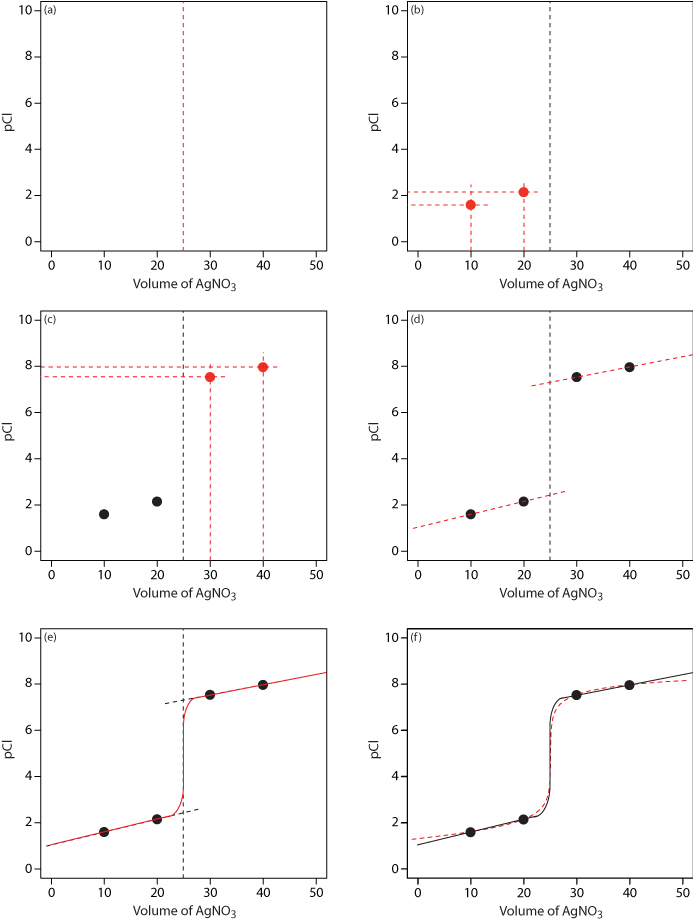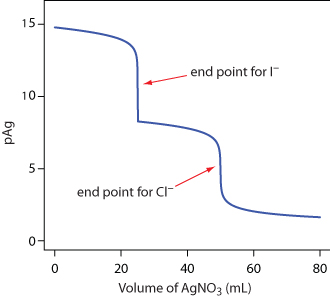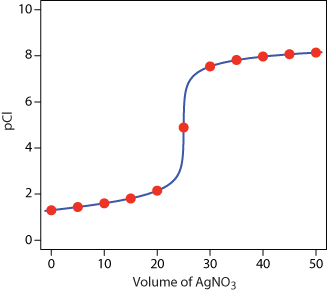9.5: Precipitation Titrations
- Page ID
- 70694
\( \newcommand{\vecs}[1]{\overset { \scriptstyle \rightharpoonup} {\mathbf{#1}} } \)
\( \newcommand{\vecd}[1]{\overset{-\!-\!\rightharpoonup}{\vphantom{a}\smash {#1}}} \)
\( \newcommand{\id}{\mathrm{id}}\) \( \newcommand{\Span}{\mathrm{span}}\)
( \newcommand{\kernel}{\mathrm{null}\,}\) \( \newcommand{\range}{\mathrm{range}\,}\)
\( \newcommand{\RealPart}{\mathrm{Re}}\) \( \newcommand{\ImaginaryPart}{\mathrm{Im}}\)
\( \newcommand{\Argument}{\mathrm{Arg}}\) \( \newcommand{\norm}[1]{\| #1 \|}\)
\( \newcommand{\inner}[2]{\langle #1, #2 \rangle}\)
\( \newcommand{\Span}{\mathrm{span}}\)
\( \newcommand{\id}{\mathrm{id}}\)
\( \newcommand{\Span}{\mathrm{span}}\)
\( \newcommand{\kernel}{\mathrm{null}\,}\)
\( \newcommand{\range}{\mathrm{range}\,}\)
\( \newcommand{\RealPart}{\mathrm{Re}}\)
\( \newcommand{\ImaginaryPart}{\mathrm{Im}}\)
\( \newcommand{\Argument}{\mathrm{Arg}}\)
\( \newcommand{\norm}[1]{\| #1 \|}\)
\( \newcommand{\inner}[2]{\langle #1, #2 \rangle}\)
\( \newcommand{\Span}{\mathrm{span}}\) \( \newcommand{\AA}{\unicode[.8,0]{x212B}}\)
\( \newcommand{\vectorA}[1]{\vec{#1}} % arrow\)
\( \newcommand{\vectorAt}[1]{\vec{\text{#1}}} % arrow\)
\( \newcommand{\vectorB}[1]{\overset { \scriptstyle \rightharpoonup} {\mathbf{#1}} } \)
\( \newcommand{\vectorC}[1]{\textbf{#1}} \)
\( \newcommand{\vectorD}[1]{\overrightarrow{#1}} \)
\( \newcommand{\vectorDt}[1]{\overrightarrow{\text{#1}}} \)
\( \newcommand{\vectE}[1]{\overset{-\!-\!\rightharpoonup}{\vphantom{a}\smash{\mathbf {#1}}}} \)
\( \newcommand{\vecs}[1]{\overset { \scriptstyle \rightharpoonup} {\mathbf{#1}} } \)
\( \newcommand{\vecd}[1]{\overset{-\!-\!\rightharpoonup}{\vphantom{a}\smash {#1}}} \)
\(\newcommand{\avec}{\mathbf a}\) \(\newcommand{\bvec}{\mathbf b}\) \(\newcommand{\cvec}{\mathbf c}\) \(\newcommand{\dvec}{\mathbf d}\) \(\newcommand{\dtil}{\widetilde{\mathbf d}}\) \(\newcommand{\evec}{\mathbf e}\) \(\newcommand{\fvec}{\mathbf f}\) \(\newcommand{\nvec}{\mathbf n}\) \(\newcommand{\pvec}{\mathbf p}\) \(\newcommand{\qvec}{\mathbf q}\) \(\newcommand{\svec}{\mathbf s}\) \(\newcommand{\tvec}{\mathbf t}\) \(\newcommand{\uvec}{\mathbf u}\) \(\newcommand{\vvec}{\mathbf v}\) \(\newcommand{\wvec}{\mathbf w}\) \(\newcommand{\xvec}{\mathbf x}\) \(\newcommand{\yvec}{\mathbf y}\) \(\newcommand{\zvec}{\mathbf z}\) \(\newcommand{\rvec}{\mathbf r}\) \(\newcommand{\mvec}{\mathbf m}\) \(\newcommand{\zerovec}{\mathbf 0}\) \(\newcommand{\onevec}{\mathbf 1}\) \(\newcommand{\real}{\mathbb R}\) \(\newcommand{\twovec}[2]{\left[\begin{array}{r}#1 \\ #2 \end{array}\right]}\) \(\newcommand{\ctwovec}[2]{\left[\begin{array}{c}#1 \\ #2 \end{array}\right]}\) \(\newcommand{\threevec}[3]{\left[\begin{array}{r}#1 \\ #2 \\ #3 \end{array}\right]}\) \(\newcommand{\cthreevec}[3]{\left[\begin{array}{c}#1 \\ #2 \\ #3 \end{array}\right]}\) \(\newcommand{\fourvec}[4]{\left[\begin{array}{r}#1 \\ #2 \\ #3 \\ #4 \end{array}\right]}\) \(\newcommand{\cfourvec}[4]{\left[\begin{array}{c}#1 \\ #2 \\ #3 \\ #4 \end{array}\right]}\) \(\newcommand{\fivevec}[5]{\left[\begin{array}{r}#1 \\ #2 \\ #3 \\ #4 \\ #5 \\ \end{array}\right]}\) \(\newcommand{\cfivevec}[5]{\left[\begin{array}{c}#1 \\ #2 \\ #3 \\ #4 \\ #5 \\ \end{array}\right]}\) \(\newcommand{\mattwo}[4]{\left[\begin{array}{rr}#1 \amp #2 \\ #3 \amp #4 \\ \end{array}\right]}\) \(\newcommand{\laspan}[1]{\text{Span}\{#1\}}\) \(\newcommand{\bcal}{\cal B}\) \(\newcommand{\ccal}{\cal C}\) \(\newcommand{\scal}{\cal S}\) \(\newcommand{\wcal}{\cal W}\) \(\newcommand{\ecal}{\cal E}\) \(\newcommand{\coords}[2]{\left\{#1\right\}_{#2}}\) \(\newcommand{\gray}[1]{\color{gray}{#1}}\) \(\newcommand{\lgray}[1]{\color{lightgray}{#1}}\) \(\newcommand{\rank}{\operatorname{rank}}\) \(\newcommand{\row}{\text{Row}}\) \(\newcommand{\col}{\text{Col}}\) \(\renewcommand{\row}{\text{Row}}\) \(\newcommand{\nul}{\text{Nul}}\) \(\newcommand{\var}{\text{Var}}\) \(\newcommand{\corr}{\text{corr}}\) \(\newcommand{\len}[1]{\left|#1\right|}\) \(\newcommand{\bbar}{\overline{\bvec}}\) \(\newcommand{\bhat}{\widehat{\bvec}}\) \(\newcommand{\bperp}{\bvec^\perp}\) \(\newcommand{\xhat}{\widehat{\xvec}}\) \(\newcommand{\vhat}{\widehat{\vvec}}\) \(\newcommand{\uhat}{\widehat{\uvec}}\) \(\newcommand{\what}{\widehat{\wvec}}\) \(\newcommand{\Sighat}{\widehat{\Sigma}}\) \(\newcommand{\lt}{<}\) \(\newcommand{\gt}{>}\) \(\newcommand{\amp}{&}\) \(\definecolor{fillinmathshade}{gray}{0.9}\)Thus far we have examined titrimetric methods based on acid–base, complexation, and redox reactions. A reaction in which the analyte and titrant form an insoluble precipitate also can serve as the basis for a titration. We call this type of titration a precipitation titration.
One of the earliest precipitation titrations—developed at the end of the eighteenth century—was the analysis of K2CO3 and K2SO4 in potash. Calcium nitrate, Ca(NO3)2, was used as the titrant, forming a precipitate of CaCO3 and CaSO4. The titration’s end point was signaled by noting when the addition of titrant ceased to generate additional precipitate. The importance of precipitation titrimetry as an analytical method reached its zenith in the nineteenth century when several methods were developed for determining Ag+ and halide ions.
9.5.1 Titration Curves
A precipitation titration curve follows the change in either the titrand’s or the titrant’s concentration as a function of the titrant’s volume. As we have done with other titrations, we first show how to calculate the titration curve and then demonstrate how we can quickly sketch a reasonable approximation of the titration curve.
Calculating the Titration Curve
Let’s calculate the titration curve for the titration of 50.0 mL of 0.0500 M NaCl with 0.100 M AgNO3. The reaction in this case is
\[\mathrm{Ag}^+(aq)+\mathrm{Cl}^-(aq)\rightleftharpoons \mathrm{AgCl}(s)\]
Because the reaction’s equilibrium constant is so large
\[K=(K_\textrm{sp})^{-1}=(1.8\times10^{-10})^{-1}=5.6\times10^9\]
we may assume that Ag+ and Cl– react completely.
Note
Step 1: Calculate the volume of AgNO3 needed to reach the equivalence point.
By now you are familiar with our approach to calculating a titration curve. The first task is to calculate the volume of Ag+ needed to reach the equivalence point. The stoichiometry of the reaction requires that
\[\mathrm{moles\;Ag^+=moles\;Cl^-}\]
\[M_\textrm{Ag}\times V_\textrm{Ag}=M_\textrm{Cl}\times V_\textrm{Cl}\]
Solving for the volume of Ag+
\[V_\textrm{eq}=V_\textrm{Ag}=\dfrac{M_\textrm{Cl}V_\textrm{Cl}}{M_\textrm{Ag}}=\dfrac{\textrm{(0.0500 M)(50.0 mL)}}{\textrm{(0.100 M)}}=\textrm{25.0 mL}\]
shows that we need 25.0 mL of Ag+ to reach the equivalence point.
Note
Step 2: Calculate pCl before the equivalence point by determining the concentration of unreacted NaCl.
Before the equivalence point the titrand, Cl–, is in excess. The concentration of unreacted Cl– after adding 10.0 mL of Ag+, for example, is
\[\begin{align}
[\textrm{Cl}^-]&=\dfrac{\textrm{initial moles Cl}^- - \textrm{moles Ag}^+\textrm{ added}}{\textrm{total volume}}=\dfrac{M_\textrm{Cl}V_\textrm{Cl}-M_\textrm{Ag}V_\textrm{Ag}}{V_\textrm{Cl}+V_\textrm{Ag}}\\
&=\mathrm{\dfrac{(0.0500\;M)(50.0\;mL)-(0.100\;M)(10.0\;mL)}{50.0\;mL+10.0\;mL}=2.50\times10^{-2}\;M}
\end{align}\]
which corresponds to a pCl of 1.60.
Note
Step 3: Calculate pCl at the equivalence point using the Ksp for AgCl to calculate the concentration of Cl–.
At the titration’s equivalence point, we know that the concentrations of Ag+ and Cl– are equal. To calculate the concentration of Cl– we use the Ksp expression for AgCl; thus
\[K_\textrm{sp}=\mathrm{[Ag^+][Cl^-]}=(x)(x)=1.8\times10^{-10}\]
Solving for x gives [Cl−] as 1.3 × 10–5 M, or a pCl of 4.89.
Note
Step 4: Calculate pCl after the equivalence point by first calculating the concentration of excess AgNO3 and then calculating the concentration of Cl– using the Ksp for AgCl.
After the equivalence point, the titrant is in excess. We first calculate the concentration of excess Ag+ and then use the Ksp expression to calculate the concentration of Cl–. For example, after adding 35.0 mL of titrant
\[\begin{align}
[\textrm{Ag}^+]&=\dfrac{\textrm{moles Ag}^+\textrm{ added}-\textrm{initial moles Cl}^-}{\textrm{total volume}}=\dfrac{M_\textrm{Ag}V_\textrm{Ag}-M_\textrm{Cl}V_\textrm{Cl}}{V_\textrm{Cl}+V_\textrm{Ag}}\\
&=\dfrac{\textrm{(0.100 M)(35.0 mL)}-\textrm{(0.0500 M)(50.0 mL)}}{\textrm{50.0 mL + 35.0 mL}}=1.18\times10^{-2}\textrm{ M}
\end{align}\]
\[[\textrm{Cl}^-]=\dfrac{K_\textrm{sp}}{[\textrm{Ag}^+]}=\dfrac{1.8\times10^{-10}}{1.18\times10^{-2}}=1.5\times10^{-8}\textrm{ M}\]
or a pCl of 7.81. Additional results for the titration curve are shown in Table 9.18 and Figure 9.43.
| Volume of AgNO3 (mL) | pCl | Volume of AgNO3 (mL) | pCl |
|---|---|---|---|
| 0.00 | 1.30 | 30.0 | 7.54 |
| 5.00 | 1.44 | 35.0 | 7.82 |
| 10.0 | 1.60 | 40.0 | 7.97 |
| 15.0 | 1.81 | 45.0 | 8.07 |
| 20.0 | 2.15 | 50.0 | 8.14 |
| 25.0 | 4.89 |
Figure 9.43 Titration curve for the titration of 50.0 mL of 0.0500 M NaCl with 0.100 M AgNO3. The red points corresponds to the data in Table 9.18. The blue line shows the complete titration curve.
When calculating a precipitation titration curve, you can choose to follow the change in the titrant’s concentration or the change in the titrand’s concentration. Calculate the titration curve for the titration of 50.0 mL of 0.0500 M AgNO3 with 0.100 M NaCl as pAg versus VNaCl, and as pCl versus VNaCl.
Click here to review your answer to this exercise.
Sketching the Titration Curve
To evaluate the relationship between a titration’s equivalence point and its end point we need to construct only a reasonable approximation of the exact titration curve. In this section we demonstrate a simple method for sketching a precipitation titration curve. Our goal is to sketch the titration curve quickly, using as few calculations as possible. Let’s use the titration of 50.0 mL of 0.0500 M NaCl with 0.100 M AgNO3.
Note
This is the same example that we used in developing the calculations for a precipitation titration curve. You can review the results of that calculation in Table 9.18 and Figure 9.43.
We begin by calculating the titration’s equivalence point volume, which, as we determined earlier, is 25.0 mL. Next we draw our axes, placing pCl on the y-axis and the titrant’s volume on the x-axis. To indicate the equivalence point’s volume, we draw a vertical line corresponding to 25.0 mL of AgNO3. Figure 9.44a shows the result of this first step in our sketch.
Before the equivalence point, Cl– is present in excess and pCl is determined by the concentration of unreacted Cl–. As we learned earlier, the calculations are straightforward. Figure 9.44b shows pCl after adding 10.0 mL and 20.0 mL of AgNO3.
Note
See Table 9.18 for the values.
After the equivalence point, Ag+ is in excess and the concentration of Cl– is determined by the solubility of AgCl. Again, the calculations are straightforward. Figure 4.43c shows pCl after adding 30.0 mL and 40.0 mL of AgNO3.
Note
See Table 9.18 for the values.
Next, we draw a straight line through each pair of points, extending them through the vertical line representing the equivalence point’s volume (Figure 9.44d). Finally, we complete our sketch by drawing a smooth curve that connects the three straight-line segments (Figure 9.44e). A comparison of our sketch to the exact titration curve (Figure 9.44f) shows that they are in close agreement.

Figure 9.44 Illustrations showing the steps in sketching an approximate titration curve for the titration of 50.0 mL of 0.0500 M NaCl with 0.100 M AgNO3: (a) locating the equivalence point volume; (b) plotting two points before the equivalence point; (c) plotting two points after the equivalence point; (d) preliminary approximation of titration curve using straight-lines; (e) final approximation of titration curve using a smooth curve; (f) comparison of approximate titration curve (solid black line) and exact titration curve (dashed red line). See the text for additional details. A better fit is possible if the two points before the equivalence point are further apart—for example, 0 mL and 20 mL— and the two points after the equivalence point are further apart.
9.5.2 Selecting and Evaluating the End point
At the beginning of this section we noted that the first precipitation titration used the cessation of precipitation to signal the end point. At best, this is a cumbersome method for detecting a titration’s end point. Before precipitation titrimetry became practical, better methods for identifying the end point were necessary.
Finding the End point With an Indicator
There are three general types of indicators for precipitation titrations, each of which changes color at or near the titration’s equivalence point. The first type of indicator is a species that forms a precipitate with the titrant. In the Mohr method for Cl– using Ag+ as a titrant, for example, a small amount of K2CrO4 is added to the titrand’s solution. The titration’s end point is the formation of a reddish-brown precipitate of Ag2CrO4.
Note
The Mohr method was first published in 1855 by Karl Friedrich Mohr.
Because CrO42– imparts a yellow color to the solution, which might obscure the end point, only a small amount of K2CrO4 is added. As a result, the end point is always later than the equivalence point. To compensate for this positive determinate error, an analyte-free reagent blank is analyzed to determine the volume of titrant needed to affect a change in the indicator’s color. Subtracting the end point for the reagent blank from the titrand’s end point gives the titration’s end point. Because CrO42– is a weak base, the titrand’s solution is made slightly alkaline. If the pH is too acidic, chromate is present as HCrO4– instead of CrO42–, and the Ag2CrO4 end point is delayed. The pH also must be less than 10 to avoid the precipitation of silver hydroxide.
A second type of indicator uses a species that forms a colored complex with the titrant or the titrand. In the Volhard method for Ag+ using KSCN as the titrant, for example, a small amount of Fe3+ is added to the titrand’s solution. The titration’s end point is the formation of the reddish-colored Fe(SCN)2+ complex. The titration must be carried out in an acidic solution to prevent the precipitation of Fe3+ as Fe(OH)3.
The Volhard method was first published in 1874 by Jacob Volhard.
The third type of end point uses a species that changes color when it adsorbs to the precipitate. In the Fajans method for Cl– using Ag+ as a titrant, for example, the anionic dye dichlorofluoroscein is added to the titrand’s solution. Before the end point, the precipitate of AgCl has a negative surface charge due to the adsorption of excess Cl–. Because dichlorofluoroscein also carries a negative charge, it is repelled by the precipitate and remains in solution where it has a greenish-yellow color. After the end point, the surface of the precipitate carries a positive surface charge due to the adsorption of excess Ag+. Dichlorofluoroscein now adsorbs to the precipitate’s surface where its color is pink. This change in the indicator’s color signals the end point.
The Fajans method was first published in the 1920s by Kasimir Fajans.
Finding the End point Potentiometrically
Another method for locating the end point is a potentiometric titration in which we monitor the change in the titrant’s or the titrand’s concentration using an ion-selective electrode. The end point is found by visually examining the titration curve. A further discussion of potentiometry is found in Chapter 11.
9.5.3 Quantitative Applications
Although precipitation titrimetry is rarely listed as a standard method of analysis, it may still be useful as a secondary analytical method for verifying other analytical methods. Most precipitation titrations use Ag+ as either the titrand or the titration. A titration in which Ag+ is the titrant is called an argentometric titration. Table 9.19 provides a list of several typical precipitation titrations.
| Titrand | Titranta | End Pointb |
|---|---|---|
| AsO43– | AgNO3, KSCN | Volhard |
| Br– | AgNO3 AgNO3, KSCN |
Mohr or Fajans Volhard |
| Cl– | AgNO3 AgNO3, KSCN |
Mohr or Fajans Volhard* |
| CO32– | AgNO3, KSCN | Volhard* |
| C2O42– | AgNO3, KSCN | Volhard* |
| CrO42– | AgNO3, KSCN | Volhard* |
| I– | AgNO3 AgNO3, KSCN |
Fajans Volhard |
| PO43– | AgNO3, KSCN | Volhard* |
| S2– | AgNO3, KSCN | Volhard* |
| SCN– | AgNO3, KSCN | Volhard* |
a When two reagents are listed, the analysis is by a back titration. The first reagent is added in excess and the second reagent used to back titrate the excess.
b For those Volhard methods identified with an asterisk (*) the precipitated silver salt must be removed before carrying out the back titration.
Quantitative Calculations
The quantitative relationship between the titrand and the titrant is determined by the stoichiometry of the titration reaction. If you are unsure of the balanced reaction, you can deduce the stoichiometry from the precipitate’s formula. For example, in forming a precipitate of Ag2CrO4, each mole of CrO42– reacts with two moles of Ag+.
A mixture containing only KCl and NaBr is analyzed by the Mohr method. A 0.3172-g sample is dissolved in 50 mL of water and titrated to the Ag2CrO4 end point, requiring 36.85 mL of 0.1120 M AgNO3. A blank titration requires 0.71 mL of titrant to reach the same end point. Report the %w/w KCl in the sample.
Solution
To find the moles of titrant reacting with the sample, we first need to correct for the reagent blank; thus
\[V_\textrm{Ag}=\textrm{36.85 mL}-\textrm{0.71 mL = 36.14 mL}\]
\[(\textrm{0.1120 M AgNO}_3)\times(\textrm{0.03614 L AgNO}_3) = 4.048\times10^{-3}\textrm{ mol AgNO}_3\]
Titrating with AgNO3 produces a precipitate of AgCl and AgBr. In forming the precipitates, each mole of KCl consumes one mole of AgNO3 and each mole of NaBr consumes one mole of AgNO3; thus
\[\textrm{moles KCl + moles NaBr}=4.048\times10^{-3}\]
We are interested in finding the mass of KCl, so let’s rewrite this equation in terms of mass. We know that
\[\textrm{moles KCl}=\dfrac{\textrm{g KCl}}{\textrm{74.551 g KCl/mol KCl}}\]
\[\textrm{moles NaBr}=\dfrac{\textrm{g NaBr}}{\textrm{102.89 g NaBr/mol NaBr}}\]
which we substitute back into the previous equation
\[\dfrac{\textrm{g KCl}}{\textrm{74.551 g KCl/mol KCl}}+\dfrac{\textrm{g NaBr}}{\textrm{102.89 g NaBr/mol NaBr}}=4.048\times10^{-3}\]
Because this equation has two unknowns—g KCl and g NaBr—we need another equation that includes both unknowns. A simple equation takes advantage of the fact that the sample contains only KCl and NaBr; thus,
\[\textrm{g NaBr = 0.3172 g} - \textrm{g KCl}\]
\[\dfrac{\textrm{g KCl}}{\textrm{74.551 g KCl/mol KCl}}+\dfrac{\textrm{0.3172 g}-\textrm{g KCl}}{\textrm{102.89 g NaBr/mol NaBr}}=4.048\times10^{-3}\]
\[1.341\times10^{-2}(\textrm{g KCl})+3.083\times10^{-3}-9.719\times10^{-3}(\textrm{g KCl}) = 4.048\times10^{-3}\]
\[3.69\times10^{-3}(\textrm{g KCl})=9.65\times10^{-4}\]
The sample contains 0.262 g of KCl and the %w/w KCl in the sample is
\[\dfrac{\textrm{0.262 g KCl}}{\textrm{0.3172 g sample}}\times100=\textrm{82.6% w/w KCl}\]
The analysis for I– using the Volhard method requires a back titration. A typical calculation is shown in the following example.
The %w/w I– in a 0.6712-g sample was determined by a Volhard titration. After adding 50.00 mL of 0.05619 M AgNO3 and allowing the precipitate to form, the remaining silver was back titrated with 0.05322 M KSCN, requiring 35.14 mL to reach the end point. Report the %w/w I– in the sample.
Solution
There are two precipitates in this analysis: AgNO3 and I– form a precipitate of AgI, and AgNO3 and KSCN form a precipitate of AgSCN. Each mole of I– consumes one mole of AgNO3, and each mole of KSCN consumes one mole of AgNO3; thus
\[\textrm{moles AgNO}_3=\textrm{moles I}^-\textrm{ + moles KSCN}\]
Solving for the moles of I– we find
\[\textrm{moles I}^-=\textrm{moles AgNO}_3-\textrm{moles KSCN}\]
\[\textrm{moles I}^- = M_\textrm{Ag}\times V_\textrm{Ag}-M_\textrm{KSCN}\times V_\textrm{KSCN}\]
\[\textrm{moles I}^-=(\textrm{0.05619 M AgNO}_3)\times(\textrm{0.05000 L AgNO}_3)-(\textrm{0.05322 M KSCN})\times(\textrm{0.03514 L KSCN})\]
that there are 9.393 × 10–4 moles of I– in the sample. The %w/w I– in the sample is
\[\dfrac{(9.393\times10^{-4}\textrm{ mol I}^-)\times 126.9\textrm{ g I}^- /\textrm{mol I}^-}{\textrm{0.6712 g sample}}\times100=17.76\%\textrm{ w/w I}^-\]
A 1.963-g sample of an alloy is dissolved in HNO3 and diluted to volume in a 100-mL volumetric flask. Titrating a 25.00-mL portion with 0.1078 M KSCN requires 27.19 mL to reach the end point. Calculate the %w/w Ag in the alloy.
Click here to review your answer to this exercise.
9.5.4 Evaluation of Precipitation Titrimetry
The scale of operations, accuracy, precision, sensitivity, time, and cost of a precipitation titration is similar to those described elsewhere in this chapter for acid–base, complexation, and redox titrations. Precipitation titrations also can be extended to the analysis of mixtures provided that there is a significant difference in the solubilities of the precipitates. Figure 9.45 shows an example of a titration curve for a mixture of I– and Cl– using Ag+ as a titrant.

Figure 9.45 Titration curve for the titration of a 50.0 mL mixture of 0.0500 M I– and 0.0500 M Cl– using 0.100 M Ag+ as a titrant. The red arrows show the end points. Note that the end point for I– is earlier than the end point for Cl– because AgI is less soluble than AgCl.


